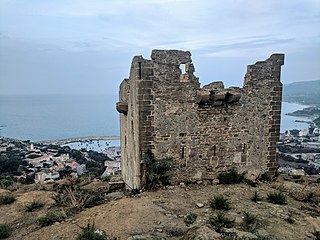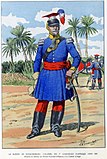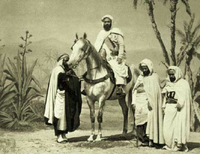
Algiers Province is a province (wilayah) in Algeria, named after its capital, Algiers, which is also the national capital. It is adopted from the old French department of Algiers and has a population of about 8 million. It is the most densely populated province of Algeria, and also the smallest by area.

Charles-Marie Denys, comte de Damrémont was a French general and military governor of French Algeria. He was killed in combat during the siege of Constantine.
The First Expedition of Blida took place from 22 to 24 July 1830, during the French conquest of Algeria.

The Battle of the Col des Beni Aïcha or Battle of Thenia, which broke out on 19 April 1871, was a battle of the Mokrani Revolt between the Algerian rebels, and the France, which was the colonial power in the region since 1830.

The Expedition of the Col des Beni Aïcha in May 1837, during the French conquest of Algeria, pitted the troupes coloniales under Colonel Maximilien Joseph Schauenburg against the troops of Beni Aïcha of the Igawawen.

Maximilien Joseph Schauenburg was a French officer who participated to the French conquest of Algeria.

The First Battle of Boudouaou in 25–26 May 1837, during the French conquest of Algeria, pitted the troupes coloniales under Colonel Maximilien Joseph Schauenburg against the troops of Kabylia of the Igawawen.
Antoine de La Torré was a French officer who participated in the French conquest of Algeria.

The Raid on Reghaïa in May 1837, during the French conquest of Algeria, pitted the French colonizers in Reghaïa region against the Kabyle troops of the Igawawen confederacy.
Mustapha ibn Muhieddine, known as Emir Mustapha, Sidi Moustafa, Moustafa El Hassani El Djazairi, was an Algerian religious and military leader who led a struggle against the French colonial invasion in the mid-19th century with his brother, Emir Abdelkader.
Zawiyet Sidi Amar Cherif, or Zawiyet Sidi Daoud, is a zawiya school located in Boumerdès Province in Algeria.
Paul-Eugène Marquis de Faudoas-Barbazan was a French officer who participated in the French conquest of Algeria.

The First Battle of the Issers in May 1837, during the French conquest of Algeria, pitted the troupes coloniales under General Perrégaux and Colonel Schauenburg against the troops of Kabylia of the Igawawen.
Jean-François-Madeleine de Gentil was a French officer who participated to the French conquest of Algeria.

The Battle of the Col des Beni Aïcha (1846) or Battle of Thénia (1846), which broke out on 3 February 1846, was a battle of the French conquest of Algeria between the Algerian rebels, and the France, which was the colonial power in the region since 1830.
Félix-Ariel Flamen d'Assigny was a French officer who participated to the French conquest of Algeria.

The First Assault of Dellys in May 1837, during the French conquest of Algeria, opposed the troupes coloniales under Corvette captain Félix-Ariel d'Assigny (1794–1846) to the resistance fighters of the town of Dellys in Kabylia of the Igawawen.
The Shipwreck of Dellys took place in May 1830, during the French conquest of Algeria. It involved French troupes coloniales, under captains Félix-Ariel d'Assigny (1794-1846) and Armand Joseph Bruat (1796-1855), who were captured by the resistance fighters of the town of Dellys in Kabylia of the Igawawen.

The Second Assault of Dellys was an assault by troupes coloniales under General Thomas Robert Bugeaud (1784–1849) against the Algerian resistance fighters in the town of Dellys, Kabylia of the Igawawen. It was part of the French conquest of Algeria and took place in April–May 1844.
Omar ben Zamoum was a Kabyle marabout who participated to the Algerian resistance during Mokrani Revolt against the French conquest of Algeria.













